By Swapnil Bhartiya, Founder & Writer at TFiR: The Fourth Industrial Revolution

Swapnil is a journalist and writer who has been covering Linux & Open Source for 10 years. He is also a science fiction writer whose stories have been broadcast on Indian radio and published in leading Indian magazines.
To better gauge how quickly Asian companies are adopting open source and cloud native technologies like Kubernetes and Prometheus, CNCF recently conducted its cloud native survey in Chinese. The bi-annual survey takes a pulse of the community to understand the adoption of cloud native technologies. More than 700 people responded to the December 2017 surveys, with 500 responding to the English version and 187 responding to the Chinese version.
For the first time, we have a very comprehensive sample and data to understand the adoption of cloud native technologies in China. Since the survey was conducted in Mandarin, it reflects the Chinese market more than the overall Asian market, excluding major economies like Japan. We expect that future surveys will be conducted in more languages to get an ever clearer picture.
KubeCon + CloudNativeCon Europe is around the corner from May 2-4 in Copenhagen, and the first KubeCon + CloudNativeCon will be held in China in November. It will be interesting to see how the representation and responses change as CNCF reaches new developers, vendors, and user attendees in other parts of the world. I can’t wait for the next KubeCon to learn more about the cloud native journey of Asian players. Read on to learn more about new cloud native developments in China.
P.S. This blog is a follow up to “Cloud Native Technologies Are Scaling Production Applications,” which analyzed trends and data from our global survey conducted in English.
China, an open source cloud native powerhouse
The survey data collected validates the fact that China is embracing cloud native and open source technologies at a phenomenal rate.
We already know the famous BAT (Baidu, Alibaba and Tencent) organizations are using open source technologies to build their services that serve more than a billion users. For example, I recently interviewed Bowyer Liu, the chief architect at Tencent, which built their own public cloud using OpenStack. It’s called TStack, which is running more than 12,000 virtual machines (VMs), covering 17 clusters, spread across 7 data centers in 4 regions. TStack is managing more than 300 services that include QQ and WeChat. TStack is also using open source projects like CoreOS, Docker, Kubernetes, KVM, HAProxy, Keepalived, Clear Container, Rabbitmq, MariaDB, Nginx, Ansible, Jenkins, Git, ELK, Zabbix, Grafana, InfluxDB, Tempest and Rally.
Of the 18 CNCF platinum members, 4 are located in Asia; of its 8 gold members, 3 are based in Asia. The community runs 18 CNCF Meetups across Asia, with 8 in China alone. Furthermore, in the past quarter, 3 of the top 10 most active companies — Huawei, Fujitsu and Treasure Data — contributing across all CNCF projects are based in Asia.
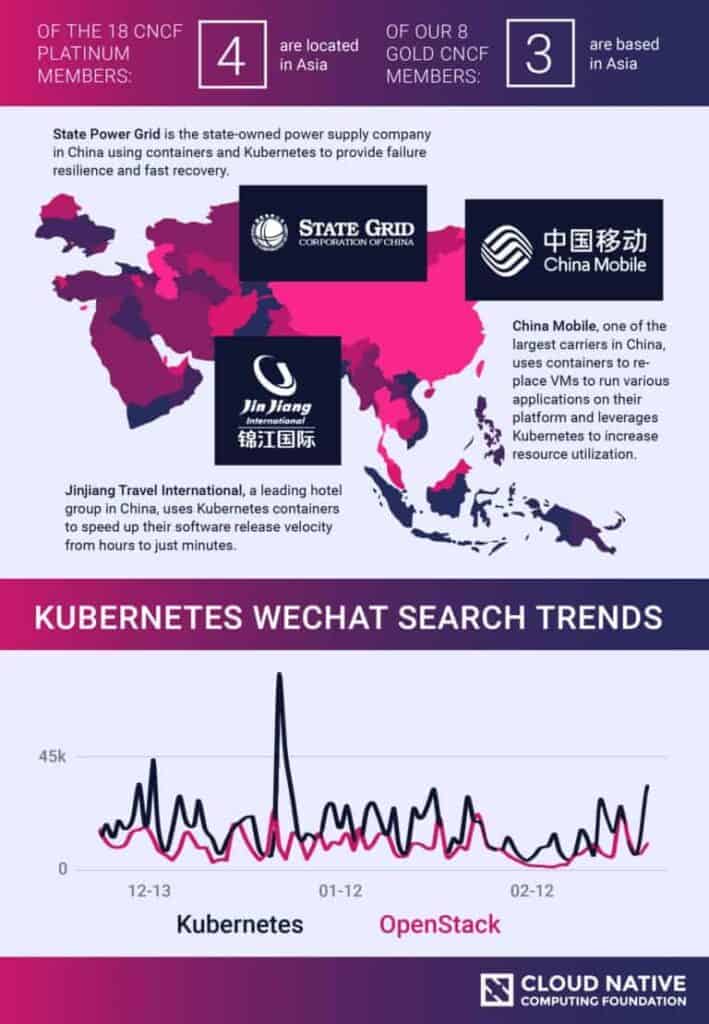
About the survey methodology & respondents
The respondents represented a variety of company sizes from small startups to large enterprises:
- Over 5000 employees: 22%
- 1000-4999 employees: 16%
- 500-999: 14%
- 100-499: 27%
- 50-99: 12%
- 10-49: 8%
Out of the total respondents, 26% represented the tech industry; 13% represented Container/Cloud Solutions vendors, 12% came from the Financial Services industry; 11% from the Consumer industry; 6% from the Government and 6% from Manufacturing. In comparison, the North American survey had 44% representation from the tech industry and the second largest representation was from the container/cloud vendors 14%, the financial services industry was the 3rd largest with 7% representation. China is embracing cloud native technologies across the board, and the Chinese financial service industry seems to be more open to cloud native technologies as compared to their Western counterparts.
What cloud are they running?
While public cloud continues to dominate the U.S. market, the Chinese market is more diverse. 24% of respondents were using private cloud and only 16% were using public cloud. 60% of respondents were using on-prem. Compare that number to North America where more than 81% of respondents were using the public cloud, and 61% were running on premise; whereas 44% are using some private cloud.
In China, Alibaba Cloud remains the leader with more than 55% of respondents said to be using it, 30% were using AWS, 28% were using OpenStack Cloud, 12% were using Microsoft Azure and around 6% were using Google Cloud Platform.
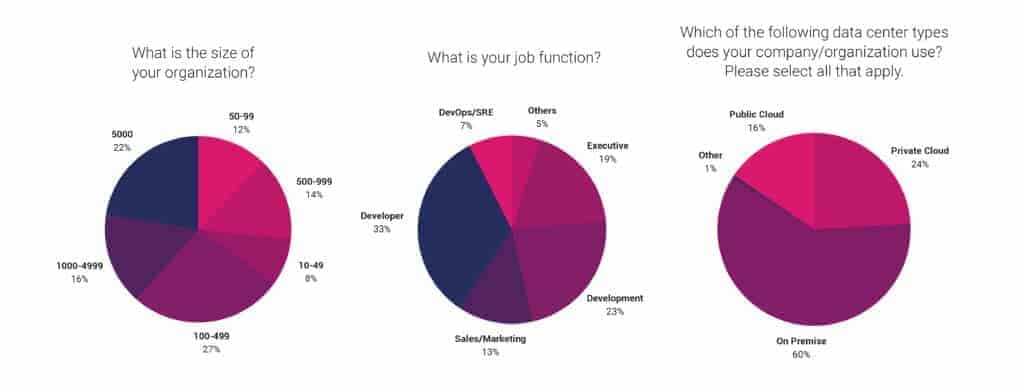
In North America, AWS remains the leader with 70% of respondents deploying their containers in AWS environment. Google Cloud Platform was at the second spot with 40% and Microsoft Azure took the 3rd spot with 23%. Compared to China, only 22% of respondents from North America acknowledged using OpenStack.
Growth of containers
Out of the total respondents, only 6% were using more than 5,000 containers. A majority of the respondents, around 32% are using less than 50 containers, and around 30% of respondents were using 50-249 containers. 36% of respondents were using containers in development stage, whereas 32% were using it in production. 57% of respondents said that they are planning to use containers in production in future. A majority of respondents (22%) are using between 6-20 machines in their fleet, with 21-50 machines close behind at 17%; only 6% have more than 5,000 machines, which includes VMs and bare metal.
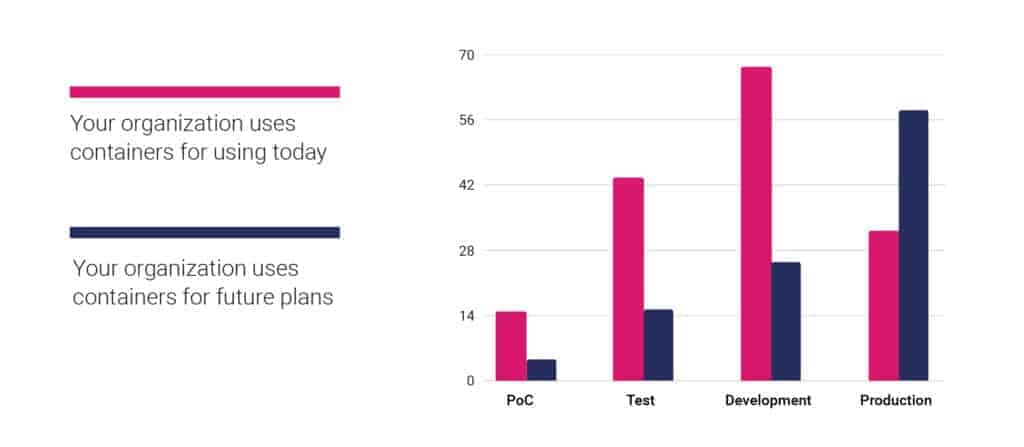
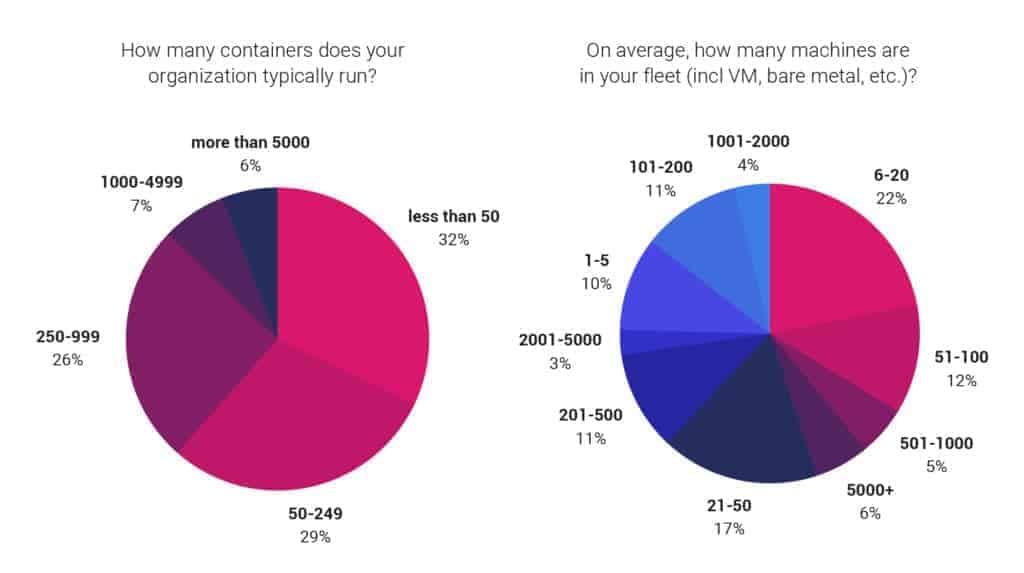
What about Kubernetes?
No surprises — Kubernetes remains the No. 1 platform to manage containers. 35% of Asian respondents said they were using Kubernetes to manage their containers. Azure Container Service was used by 19%. Docker Swarm was reported to be used by 16% of respondents. ECS came in at the 4 spot with 13% and 11% reporting using another Linux Foundation Project Cloud Foundry. 6% said they were using OpenShift, while another 6% reported using CoreOS Tectonic. This data shows a much more diverse cloud native ecosystem in China as compared to the United States.
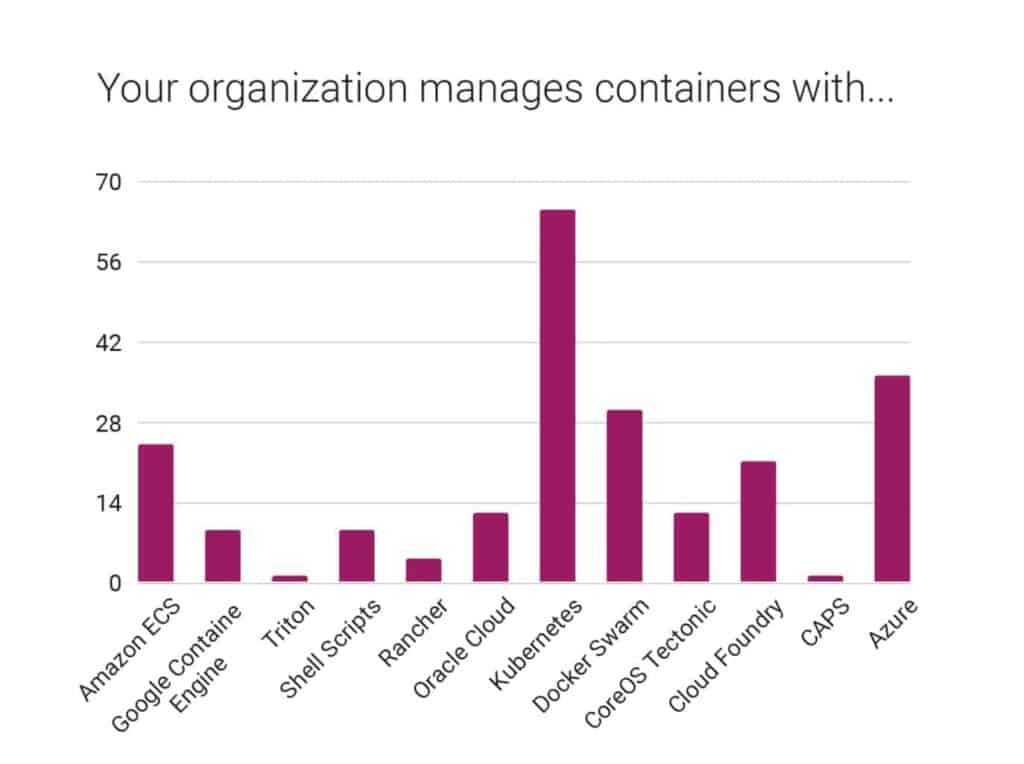
Where are they running Kubernetes?
The most interesting finding from the survey was that more than 49% of respondents were using Kubernetes in production, with another 49% evaluating it for use. Some of the most well-known examples include Jinjiang Travel International, one of the top 5 largest OTA and hotel companies that sells hotels, travel packages, and car rentals. They use Kubernetes containers to speed up their software release velocity from hours to just minutes, and they leverage Kubernetes to increase the scalability and availability of their online workloads. China Mobile uses containers to replace VMs to run various applications on their platform in a lightweight fashion, leveraging Kubernetes to increase resource utilization. State Power Grid, the state-owned power supply company in China, uses containers and Kubernetes to provide failure resilience and fast recovery. JD.com, one of China’s largest companies and the first Chinese Internet company to make the Global Fortune 500 list, chronicled their shift to Kubernetes from OpenStack in this blog from last year.
As expected, 52% of respondents were using Kubernetes with Alibaba public cloud, 26% were using AWS. China is bigger consumer of OpenStack as compared to the North America market (16%), around 26% of respondents were using OpenStack. A majority of respondents were running 10 or less clusters in production; 14% were running 1 cluster, 40% were running 2-5 clusters and 26% were running 6-10 clusters. Only 6% of the respondents running Kubernetes have more than 50 clusters in production.
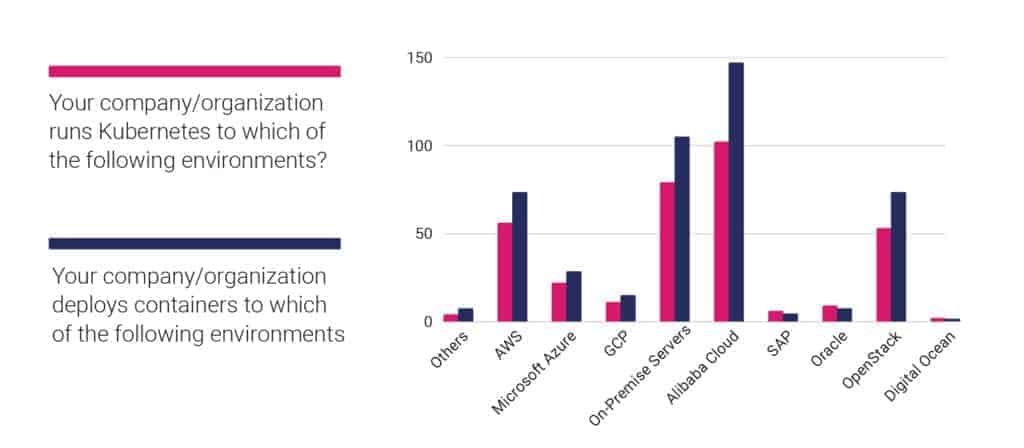
One ring to bind them all…
CNCF is at the bedrock of this cloud native movement and the survey shows adoption of CNCF projects is growing quickly in China. While Kubernetes remains the crown jewel, other CNCF projects are getting into production. 20% of respondents were running OpenTracing in production; 16% were using Prometheus; 13% were using gRPC; 10% were using CoreDNS; and 7% were using Fluentd. China is still warming up to newer projects like Istio where only 3% of respondents were using it in production.
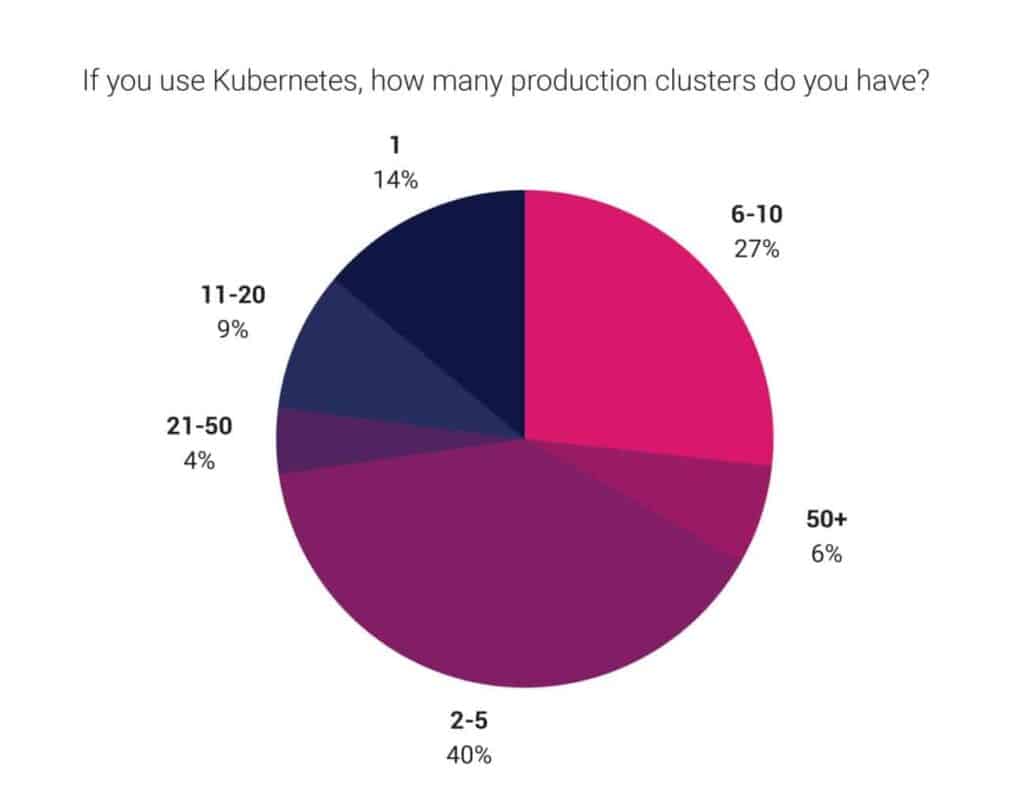
Talking about new CNCF projects, we can’t ignore ‘serverless’ or ‘function as a service.’ The CNCF Serverless Working Group recently came out with a whitepaper to define serverless computing. The survey found that more than 25% of respondents are already using serverless technology and around 23% planned to use it in the next 12-18 months.
China leans heavily toward open source when it comes to serverless technologies. Apache OpenWhisk is the dominant serverless platform in China with more than 30% of respondents using it as their preferred platform. AWS Lambda is in the second spot with 24% of respondents using it. Azure was mentioned by 14% and Google Cloud Functions was mentioned by 9% of respondents.
We will hear more about serverless technologies in 2018, especially at the upcoming KubeCon + CloudNativeCon, May 2-4 in Copenhagen.
Challenges ahead
As impressive as the findings of the survey are, we are talking about some fairly young technologies. Respondents cited many new and old challenges. Complexity remains the No. 1 concern, with more than 44% of respondents citing it as their biggest challenge followed by reliability (43%); monitoring (38%); and difficulty in choosing an orchestration solution (40%).
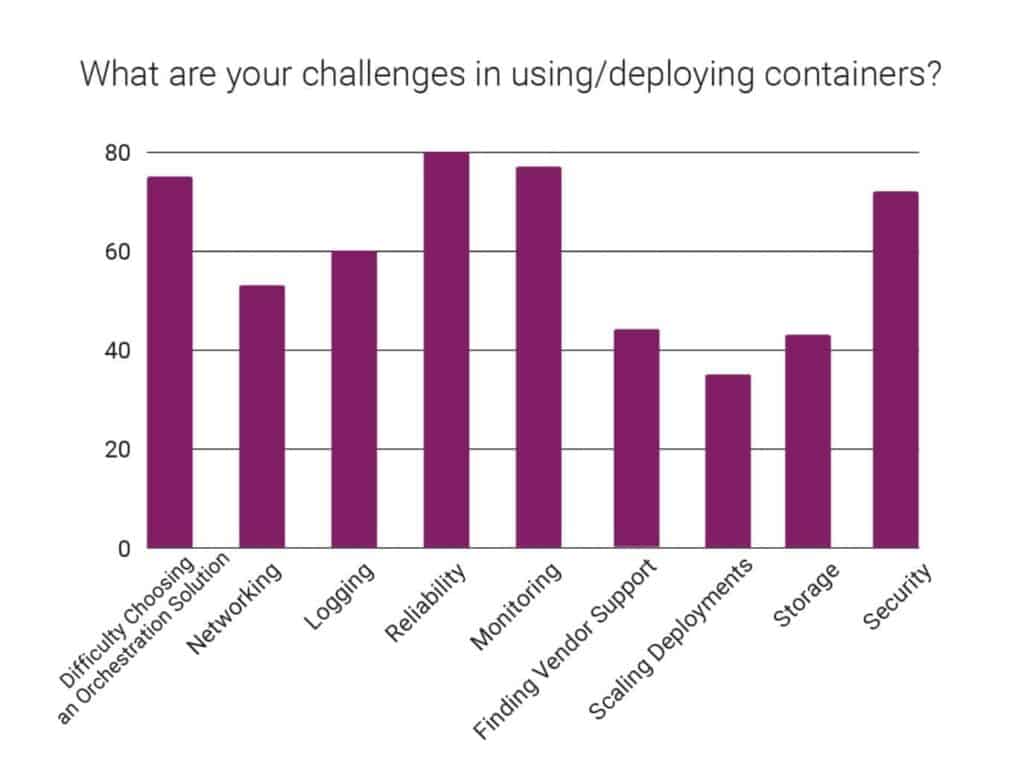
In contrast, for the North American respondents security remains the No. 1 concern, with 43% of respondents citing it as their biggest challenge followed by storage (41%); networking (38%); monitoring (38%); complexity (35%) and logging (32%).
This is a clear indication that the Chinese market is younger and still going through basic challenges that their Western counterparts have already overcome. To help Chinese companies move forward, documentation plays a very critical role in the proliferation of any technology, so it’s promising to see massive work going on to translate Kubernetes documentation into Mandarin.
The good news is that finding a vendor is not one of the biggest challenges for either of the two markets. With the release of the Certified Kubernetes Conformance Program, CNCF has instilled more confidence in users to pick and choose a vendor without fearing being locked down.
Getting ready for cloud native world?
There is no playbook to help you embark on your journey to the cloud native world. However, there are some best practices that one can follow. A little under a year ago, Dr. Ying Xiong, Chief Architect of Cloud Computing at Huawei, talked about the company’s move toward cloud native architecture at KubeCon + CloudNativeCon Europe. Dr. Xiong has some tips – start with the right set of applications for cloud native journey; some apps are too difficult to redesign with microservice architecture; don’t start with those. Choose the easy ones, as you succeed you gain confidence and a model to replicate across your organization. He also advises in favor of using one platform to manage container and non container applications.
Be sure to join us at an upcoming CNCF Meetup.
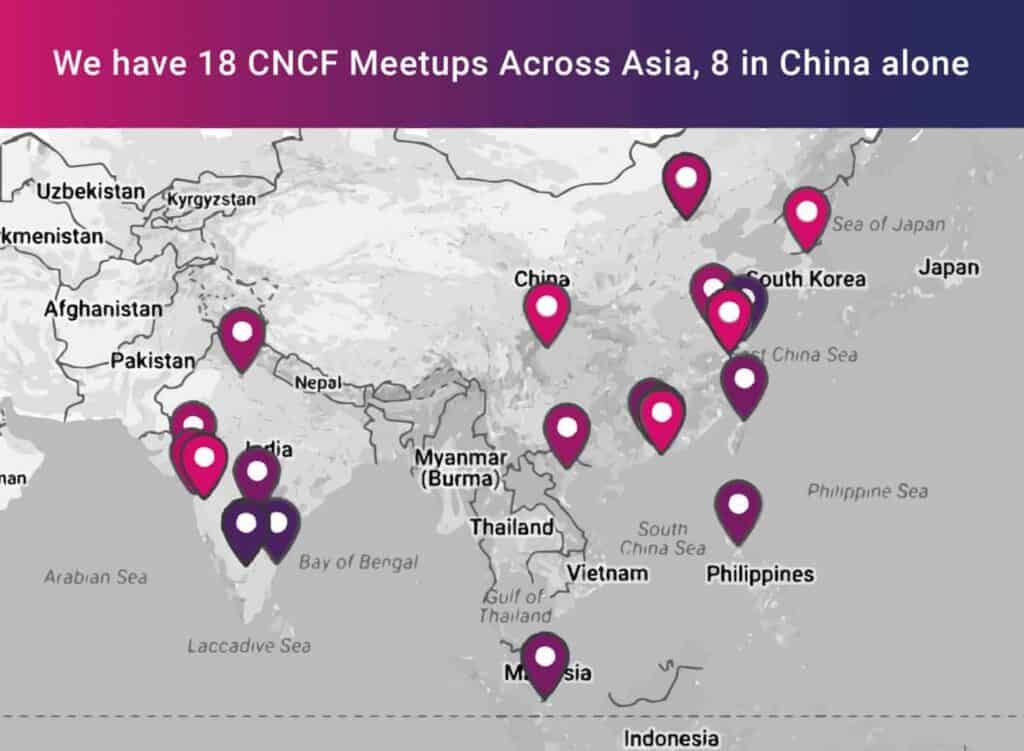
For even deeper exposure to the cloud native community, ecosystem and user successes, be sure to attend our first KubeCon + CloudNativeCon China, Nov. 14-15 in Shanghai.